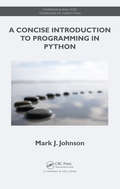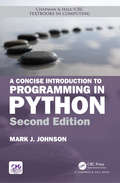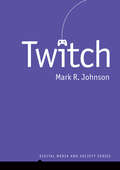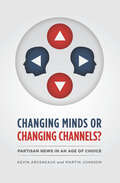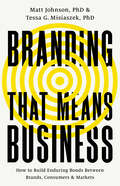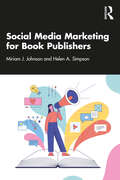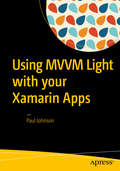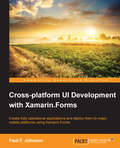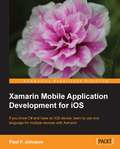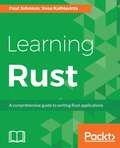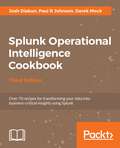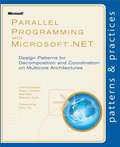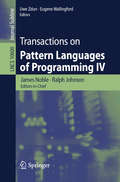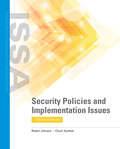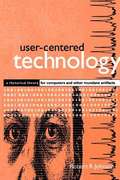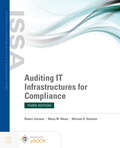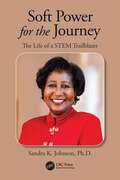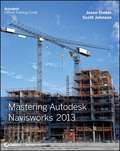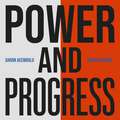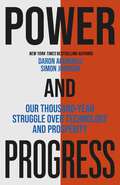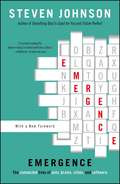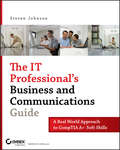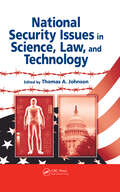- Table View
- List View
A Concise Introduction to Programming in Python (Chapman And Hall/crc Textbooks In Computing Ser.)
by Mark J. JohnsonSuitable for newcomers to computer science, A Concise Introduction to Programming in Python provides a succinct, yet complete, first course in computer science using the Python programming language. The book features:Short, modular chapters with brief and precise explanations, intended for one class periodEarly introduction of basic procedural cons
A Concise Introduction to Programming in Python (Chapman & Hall/CRC Textbooks in Computing #12)
by Mark J. JohnsonA Concise Introduction to Programming in Python, Second Edition provides a hands-on and accessible introduction to writing software in Python, with no prior programming experience required. The Second Edition was thoroughly reorganized and rewritten based on classroom experience to incorporate: A spiral approach, starting with turtle graphics, and then revisiting concepts in greater depth using numeric, textual, and image data Clear, concise explanations written for beginning students, emphasizing core principles A variety of accessible examples, focusing on key concepts Diagrams to help visualize new concepts New sections on recursion and exception handling, as well as an earlier introduction of lists, based on instructor feedback The text offers sections designed for approximately one class period each, and proceeds gradually from procedural to object-oriented design. Examples, exercises, and projects are included from diverse application domains, including finance, biology, image processing, and textual analysis. It also includes a brief "How-To" sections that introduce optional topics students may be interested in exploring. The text is written to be read, making it a good fit in flipped classrooms. Designed for either classroom use or self-study, all example programs and solutions to odd-numbered exercises (except for projects) are available at: http://www.central.edu/go/conciseintro/.
Twitch (Digital Media and Society)
by Mark R. JohnsonTwitch is the leading live streaming platform in most of the world and an integral part of contemporary digital gaming culture. Millions of people broadcast their game play (as well as other activities) to over a hundred million people who regularly visit the site. In this accessible book, Mark R. Johnson offers both a synthesis of existing Twitch research and a new way to understand Twitch as a public forum for gaming. Drawing on ideas of the ancient Greek agora or public forum, Johnson demonstrates how Twitch has become the key location for game players looking to understand what is contemporary, relevant, and important in modern gaming culture. He argues that Twitch has constructed a particular kind of public forum for gaming, an understanding which emerges from analysing the platform through its technological infrastructure, its streamers and viewers, its broadcast content, and its tightly knit communities. While this forum helps shape gaming culture, it also exhibits many of gaming's existing problems with harassment and cultural exclusivity. Despite being the essential public space for contemporary gaming, Johnson shows that Twitch is far more complex than it first appears, and is currently expanding in ways that challenge this – until now – core focus. This book is essential reading for students and scholars of game studies, media studies, and anyone with an interest in the rapidly changing nature of online communication.
Changing Minds or Changing Channels?: Partisan News in an Age of Choice (Chicago Studies in American Politics)
by Martin Johnson Kevin ArceneauxWe live in an age of media saturation, where with a few clicks of the remote--or mouse--we can tune in to programming where the facts fit our ideological predispositions. But what are the political consequences of this vast landscape of media choice? <P><P>Partisan news has been roundly castigated for reinforcing prior beliefs and contributing to the highly polarized political environment we have today, but there is little evidence to support this claim, and much of what we know about the impact of news media come from studies that were conducted at a time when viewers chose from among six channels rather than scores. <P> Through a series of innovative experiments, Kevin Arceneaux and Martin Johnson show that such criticism is unfounded. Americans who watch cable news are already polarized, and their exposure to partisan programming of their choice has little influence on their political positions. In fact, the opposite is true: viewers become more polarized when forced to watch programming that opposes their beliefs. <P>A much more troubling consequence of the ever-expanding media environment, the authors show, is that it has allowed people to tune out the news: the four top-rated partisan news programs draw a mere three percent of the total number of people watching television. <P>Overturning much of the conventional wisdom, "Changing Minds or Changing Channels?" demonstrate that the strong effects of media exposure found in past research are simply not applicable in today's more saturated media landscape.
Branding that Means Business: How to Build Enduring Bonds between Brands, Consumers and Markets
by Matt Johnson Tessa G MisiaszekA revelatory guide on how to build, sustain and grow a brand. A brand is either beloved, or it&’s noise. We live in a fast-paced world of immediate gratification where consumers can listen to any song, watch any movie, or read any article, with the touch of a few buttons. They are peppered with hyper-personalized targeting for products that can be ordered seamlessly and arrive within hours. And if your brand isn&’t the first to come to mind, they&’ll click that button and it&’ll be delivered by someone else. So how do you make sure your brand connects with consumers? Branding that Means Business draws from the authors&’ experience and business literature as well as psychology, sociology, and even anthropology to show readers that while any brand serves the business, the mechanisms that enable it are all about connecting with people. Readers will learn how to create, maintain, and operationalize their brand, and think creatively about how to differentiate their product and most importantly, make consumers fall in love with it.
Social Media Marketing for Book Publishers
by Miriam J. Johnson Helen A. SimpsonProviding a concise toolbox for publishing professionals and students of publishing, this book explores the skills needed to master the key elements of social media marketing and therefore stay relevant in this ever-competitive industry. Taking a hands-on, practical approach, Social Media Marketing for Book Publishers covers topics including researching and identifying actionable insights, developing a strategy, producing content, promotion types, community building, working with influencers, and how to measure success. Pulling from years of industry experience, the authors’ main focus is on adult fiction publishing, but they also address other areas of the industry including children’s, young adult (YA), academic, and non-fiction. The book additionally brings in valuable voices from the wider digital marketing industries, featuring excerpts from interviews with experts across search engine optimisation (SEO), AdWords, social platforms, community management, influencer management, and content strategists. Social Media Marketing for Book Publishers is a key text for any publishing courses covering how to market books, and should find a place on every publishers' bookshelf.
Using MVVM Light with your Xamarin Apps
by Paul JohnsonLearn how to use the popular MVVM Light development framework with a focus on reliable, maintainable code that can be deployed across any of the .NET-supported mobile platforms. Clear examples are provided of the advantages of the MVVM platform along with step-by-step demonstrations of how to create applications at different levels of complexity. Application development is covered for iOS, Android, and Windows phone (UWP) using MVVM Light as the central framework. The model-view-view-model (MVVM) pattern is valued by many developers as an excellent way to create sophisticated modern applications. Its clear separation of presentation and business logic produces a clean implementation that promotes speed, scalability, and code reuse in applications with a complex UI. These characteristics have long been highly valued by WPF developers, and now that benefit is available to Xamarin developers, too. What You'll Learn Set up and install MVVM Light Understand the advantages and disadvantages of MVVM Discover why inversion of control is important in MVVM Conduct unit testing of MVVM apps Convert your existing apps to use MVVM Use MVVM Light within a Xamarin Forms app Use webservices Be introduced to the new .NET 2.0 Standard Class Library and how to use MVVM Light with it
Cross-platform UI Development with Xamarin.Forms
by Paul F. JohnsonCreate a fully operating application and deploy it to major mobile platforms using Xamarin.Forms About This Book * Create standard user interfaces on Windows Mobile, Android, and iOS and then make those interfaces look good with ease * Design a full-blown application in very little time with just about the entire code being shared * Learn how to access platform-specific features and still have the same core code with this handy guide Who This Book Is For This book is intended for mobile software developers who are fed up with having three different code sets for the same application. If you want to put your code on all mobile platforms with minimum fuss, and just want to develop but haven't got the time to be digging too far into a particular platform, this is the book for you. Basic knowledge of C# is assumed. What You Will Learn * Create a responsive UI, modified to suit the target platform * Understand the basics of designing an application, and the considerations needed for target platforms * Construct a complete app using a single codebase * Develop attractive user interfaces * Bind information to the code behind to generate a reactive application * Design an effective portable class library (PCL) * Include a Windows Mobile application within your standard Xamarin.Forms application * Extend your applications using the Xamarin.Forms Labs library In Detail Xamarin is an IDE used for the development of native iOS, Android, and Windows, and cross-platform mobile applications in C#. For the mobile developer, that means learning three different languages to create the same application. Even if you use the Xamarin toolchain, you still need to work with three different user interface construction sets. Xamarin is essentially a container in which developers can write any application in C# and use the Xamarin compiler to package and deploy on Android, iOS, or Windows platforms. To top this, Xamarin.Forms plays the role of a single codebase for mobile applications. This book will show you, with fully-coded examples, how to use both the Xamarin toolchain and the Xamarin.Forms library to code once for the three platforms. It goes from the concept and design of a mobile messenger application to its execution. You will be introduced to Messenger--the messaging app--which includes key features such as push notifications, UI, maps, databases, and web services. Next, you will learn to plan the UI using Xamarin.Forms for cross-mobile platform development, and move on to creating custom buttons, extending the UI, and connecting to social sites such as Facebook and Twitter. You will also learn about the limitations of PCL libraries and how they make coding easier. This will be followed by the creation of a SQLite database and a database manager, and the SQLite database's reflection within the database manager. You will then be taken through the use of hardware features with ample coverage of iOS, Android, and Windows Mobile. Finally, the book will conclude by introducing common strategies that allow you to create applications that "just work" without having to reinvent the wheel each time. Style and approach A fun and informal approach to creating a mobile application using the most up-to-date cross-platform approach. Each coding chapter includes fully working code examples available for download from the Packt Publishing website.
Xamarin Mobile Application Development for iOS
by Paul F. JohnsonThis book is a standard tutorial aimed at teaching you everything you need to know about iOS app development using Xamarin.This book is written for those who are new to iOS app development as well as more experienced developers who just need a quick reference book. It is assumed that you are already comfortable using C#. Those teaching iOS to new students will also find this book invaluable as a form of reference material.
Learning Rust
by Paul Johnson Vesa KaihlavirtaStart building fast and robust applications with the power of Rust by your side About This Book • Get started with the language to build scalable and high performance applications • This book will help C#/C++ developers gain better performance and memory management • Discover the power of Rust when developing concurrent applications for large and scalable software Who This Book Is For The book is for absolute beginners to Rust, who want to build high performance, concurrent applications for their projects. It is suitable for developers who have a basic knowledge of programming and developers who are using the C#/C++ language to write their applications. No knowledge of Rust is expected. What You Will Learn • Set up Rust for Windows, Linux, and OS X • Write effective code using Rust • Expand your Rust applications using libraries • Interface existing non-Rust libraries with your Rust applications • Use the standard library within your applications • Understand memory management within Rust and speed efficiency when passing variables • Create more complex data types • Study concurrency in Rust with multi-threaded applications and sync threading techniques to improve the performance of an application problem In Detail Rust is a highly concurrent and high performance language that focuses on safety and speed, memory management, and writing clean code. It also guarantees thread safety, and its aim is to improve the performance of existing applications. Its potential is shown by the fact that it has been backed by Mozilla to solve the critical problem of concurrency. Learning Rust will teach you to build concurrent, fast, and robust applications. From learning the basic syntax to writing complex functions, this book will is your one stop guide to get up to speed with the fundamentals of Rust programming. We will cover the essentials of the language, including variables, procedures, output, compiling, installing, and memory handling. You will learn how to write object-oriented code, work with generics, conduct pattern matching, and build macros. You will get to know how to communicate with users and other services, as well as getting to grips with generics, scoping, and more advanced conditions. You will also discover how to extend the compilation unit in Rust. By the end of this book, you will be able to create a complex application in Rust to move forward with. Style and approach This comprehensive book will focus on the Rust syntax, functions, data types, and conducting pattern matching for programmers. It is divided into three parts and each part of the book has an objective to enable the readers to create their own applications at an appropriate level, ultimately towards creating complex applications.
Splunk Operational Intelligence Cookbook: Over 80 recipes for transforming your data into business-critical insights using Splunk, 3rd Edition
by Paul R Johnson Josh Diakun Derek MockLeverage Splunk's operational intelligence capabilities to unlock new hidden business insights and drive successKey FeaturesTackle any problems related to searching and analyzing your data with Splunk Get the latest information and business insights on Splunk 7.x Explore the all new machine learning toolkit in Splunk 7.xBook DescriptionSplunk makes it easy for you to take control of your data, and with Splunk Operational Cookbook, you can be confident that you are taking advantage of the Big Data revolution and driving your business with the cutting edge of operational intelligence and business analytics.With more than 80 recipes that demonstrate all of Splunk’s features, not only will you find quick solutions to common problems, but you’ll also learn a wide range of strategies and uncover new ideas that will make you rethink what operational intelligence means to you and your organization.You’ll discover recipes on data processing, searching and reporting, dashboards, and visualizations to make data shareable, communicable, and most importantly meaningful. You’ll also find step-by-step demonstrations that walk you through building an operational intelligence application containing vital features essential to understanding data and to help you successfully integrate a data-driven way of thinking in your organization.Throughout the book, you’ll dive deeper into Splunk, explore data models and pivots to extend your intelligence capabilities, and perform advanced searching with machine learning to explore your data in even more sophisticated ways. Splunk is changing the business landscape, so make sure you’re taking advantage of it.What you will learnLearn how to use Splunk to gather, analyze, and report on dataCreate dashboards and visualizations that make data meaningfulBuild an intelligent application with extensive functionalitiesEnrich operational data with lookups and workflowsModel and accelerate data and perform pivot-based reportingApply ML algorithms for forecasting and anomaly detectionSummarize data for long term trending, reporting, and analysisIntegrate advanced JavaScript charts and leverage Splunk's APIWho this book is forThis book is intended for data professionals who are looking to leverage the Splunk Enterprise platform as a valuable operational intelligence tool. The recipes provided in this book will appeal to individuals from all facets of business, IT, security, product, marketing, and many more! Even the existing users of Splunk who want to upgrade and get up and running with Splunk 7.x will find this book to be of great value.
Parallel Programming with Microsoft® .NET
by Ralph Johnson Colin Campbell Ade Miller Stephen ToubThe CPU meter shows the problem. One core is running at 100 percent, but all the other cores are idle. Your application is CPU-bound, but you are using only a fraction of the computing power of your multicore system. What next? The answer, in a nutshell, is parallel programming. Where you once would have written the kind of sequential code that is familiar to all programmers, you now find that this no longer meets your performance goals. To use your system's CPU resources efficiently, you need to split your application into pieces that can run at the same time. This is easier said than done. Parallel programming has a reputation for being the domain of experts and a minefield of subtle, hard-to-reproduce software defects. Everyone seems to have a favorite story about a parallel program that did not behave as expected because of a mysterious bug. These stories should inspire a healthy respect for the difficulty of the problems you face in writing your own parallel programs. Fortunately, help has arrived. Microsoft Visual Studio® 2010 introduces a new programming model for parallelism that significantly simplifies the job. Behind the scenes are supporting libraries with sophisticated algorithms that dynamically distribute computations on multicore architectures. Proven design patterns are another source of help. A Guide to Parallel Programming introduces you to the most important and frequently used patterns of parallel programming and gives executable code samples for them, using the Task Parallel Library (TPL) and Parallel LINQ (PLINQ).
Transactions on Pattern Languages of Programming IV (Lecture Notes in Computer Science #10600)
by Ralph Johnson Uwe Zdun James Noble Eugene WallingfordThe Transactions on Pattern Languages of Programming subline aims to publish papers on patterns and pattern languages as applied to software design, development, and use, throughout all phases of the software life cycle, from requirements and design to implementation, maintenance and evolution. The primary focus of this LNCS Transactions subline is on patterns, pattern collections, and pattern languages themselves. The journal also includes reviews, survey articles, criticisms of patterns and pattern languages, as well as other research on patterns and pattern languages. This book, the third volume in the Transactions on Pattern Languages of Programming series, presents five papers that have been through a careful peer review process involving both pattern experts and domain experts. The papers present various pattern languages and a study of applying patterns and represent some of the best work that has been carried out in design patterns and pattern languages of programming over the last few years.
The Elements of Matlab® Style
by Richard K. JohnsonThe Elements of MATLAB Style is a guide for both new and experienced MATLAB programmers. It provides a comprehensive collection of standards and guidelines for creating solid MATLAB code that will be easy to understand, enhance, and maintain. It is written for both individuals and those working in teams in which consistency is critical. This is the only book devoted to MATLAB style and best programming practices, focusing on how MATLAB code can be written in order to maximize its effectiveness. Just as Strunk and White's The Elements of Style provides rules for writing in the English language, this book provides conventions for formatting, naming, documentation, programming and testing. It includes many concise examples of correct and incorrect usage, as well as coverage of the latest language features. The author also provides recommendations on use of the integrated development environment features that help produce better, more consistent software.
Security Policies and Implementation Issues
by Robert Johnson Chuck EasttomPART OF THE NEW JONES & BARTLETT LEARNING INFORMATION SYSTEMS SECURITY & ASSURANCE SERIES Security Policies and Implementation Issues, Third Edition offers a comprehensive, end-to-end view of information security policies and frameworks from the raw organizational mechanics of building to the psychology of implementation. Written by industry experts, the new Third Edition presents an effective balance between technical knowledge and soft skills, while introducing many different concepts of information security in clear simple terms such as governance, regulator mandates, business drivers, legal considerations, and much more. With step-by-step examples and real-world exercises, this book is a must-have resource for students, security officers, auditors, and risk leaders looking to fully understand the process of implementing successful sets of security policies and frameworks. Instructor Materials for Security Policies and Implementation Issues include: PowerPoint Lecture Slides Instructor's Guide Sample Course Syllabus Quiz & Exam Questions Case Scenarios/Handouts About the Series This book is part of the Information Systems Security and Assurance Series from Jones and Bartlett Learning. Designed for courses and curriculums in IT Security, Cybersecurity, Information Assurance, and Information Systems Security, this series features a comprehensive, consistent treatment of the most current thinking and trends in this critical subject area. These titles deliver fundamental information-security principles packed with real-world applications and examples. Authored by Certified Information Systems Security Professionals (CISSPs), they deliver comprehensive information on all aspects of information security. Reviewed word for word by leading technical experts in the field, these books are not just current, but forward-thinking—putting you in the position to solve the cybersecurity challenges not just of today, but of tomorrow, as well.
User-Centered Technology: A Rhetorical Theory for Computers and Other Mundane Artifacts
by Robert R. JohnsonPresents a theoretical model for examining technology through a user perspective. Begins with a historical overview of the problem of technology use through the lens of rhetoric theory, and defines central areas of user-centered theory, such as user knowledge, human-technology interaction, and technological determinism. Draws also from human factors engineering, history, philosophy, and sociology to discuss ideological presuppositions of technology design and technological determinism. Ideas are applied in academic and nonacademic contexts. Annotation copyrighted by Book News, Inc., Portland, OR
Auditing IT Infrastructures for Compliance
by Robert Johnson Marty Weiss Michael G. SolomonThe third edition of Auditing IT Infrastructures for Compliance provides a unique, in-depth look at recent U.S. based Information systems and IT infrastructures compliance laws in both the public and private sector. Written by industry experts, this book provides a comprehensive explanation of how to audit IT infrastructures for compliance based on the laws and the need to protect and secure business and consumer privacy data. Using examples and exercises, this book incorporates hands-on activities to prepare readers to skillfully complete IT compliance auditing.
Soft Power for the Journey: The Life of a STEM Trailblazer
by Sandra K. JohnsonThis is a story of an African American woman working at the highest levels in STEM. Dr. Sandra K. Johnson earned a Ph.D. in electrical and computer engineering from Rice University, Houston, Texas, in May 1988, the first Black woman to do so. She then became a successful global technology leader and an IBM Chief Technology Officer (CTO). The story narrates the inextricable human dimension of dealing with various personal and familial challenges that people naturally encounter—with the highs and lows, and exhilarations and disappointments. It portrays her inner strength, persistence, dedication, boldness, quiet resilience, wisdom and strong faith, this soft power she leverages throughout her life. It is a heartwarming, compelling story designed to encourage, be aspirational and awe-inspiring, and uplift the spirits of a broad and diverse readership.From tragically losing her father at the age of two, to being raised by a single mother of four children, Sandra showed promise in math and science, and discipline and unrelenting drive at a young age. Raised in the deep South, she exhibited leadership even while in kindergarten and blazed trails in leadership while in junior high and high schools. Her early education was in segregated schools, with integration coming to her hometown as she started the 5th grade. Dr. Johnson’s innate abilities led her to a summer engineering program for high school students, then on to college and graduate school.Dr. Johnson has made innovative contributions in high performance computing – supercomputers – and other areas of computer engineering. She has dozens of technical publications, over 45 pending and issued patents, and a plethora of recognition and honors in her field. The book is a fascinating and intriguing story that conveys in captivating and relatable ways the remarkable life arc of a resilient person from an underprivileged background who persistently overcomes whatever odds and challenges are encountered in her life. It is a riveting human tale of a triumphant spirit, moving forward with soft power to celebrate achievement and handle obstacles with steel willpower, influential support, and faith.Access the authors' webpage here https://softpowerforthejourney.com/
Mastering Autodesk Navisworks 2012
by Scott Johnson Jason DoddsDesign, communicate and collaborate with Navisworks Mastering Autodesk Navisworks shows you how to best use the amazing Navisworks software. This collaboration tool enables the consolidation of all files connected to a construction project?including file formats such as Revit, SketchUp, ArchiCAD, and others?into one 3D model that all participants can view, share, navigate, and use for visualization and simulation. With the ability to support 60-plus file formats, Naviworks has an eager fan base seeking more information. Using step-by-step tutorials, real-world examples, and hands-on exercises, this thorough guide provides the complete guidance you need to master Navisworks. Introduces you to Navisworks using a workflow approach that mirrors how it is used on real projects from start to finish Explains how to import the 60+ supported file formats, navigate around the merged 3D model, document and annotate it, and coordinate schedules with TimeLiner Delves into the powerful clash detection tool, which warns you if a design will not work in the real world Covers advanced functions such as creating visualizations and using scripting tools Features step-by-step instruction, real-world examples, and downloadable before-and-after tutorial files Mastering Autodesk Navisworks is the ultimate reference on this exciting collaboration and design review software.
Power and Progress: Our Thousand-Year Struggle Over Technology and Prosperity
by Simon Johnson Daron AcemogluTwo bestselling authors deliver a bold new interpretation of why technology has all too often benefited elites - and how we must reshape the path of innovation to create true shared prosperity.A thousand years of history and contemporary evidence make one thing clear. Progress is not automatic but depends on the choices we make about technology. New ways of organizing production and communication can either serve the narrow interests of an elite or become the foundation for widespread prosperity.Much of the wealth generated by agricultural advances during the European Middle Ages was captured by the Church and used to build grand cathedrals while the peasants starved. The first hundred years of industrialization in England delivered stagnant incomes for workers, while making a few people very rich. And throughout the world today, digital technologies and artificial intelligence increase inequality and undermine democracy through excessive automation, massive data collection, and intrusive surveillance.It doesn't have to be this way. Power and Progress demonstrates that the path of technology was once - and can again be - brought under control. The tremendous computing advances of the last half century can become empowering and democratizing tools, but not if all major decisions remain in the hands of a few hubristic tech leaders striving to build a society that elevates their own power and prestige.With their breakthrough economic theory and manifesto for a better society, Acemoglu and Johnson provide the understanding and the vision to reshape how we innovate and who really gains from technological advances so we can create real prosperity for all.(P) 2023 Hachette Audio
Power and Progress: Our Thousand-Year Struggle Over Technology and Prosperity
by Simon Johnson Daron Acemoglu'The blueprint we need for the challenges ahead' Shoshana Zuboff'If you are not already an addict of Daron Acemoglu and Simon Johnson's previous books, Power and Progress is guaranteed to make you one' Jared Diamond'A breathtaking tour of the history and future of technology' Abhijit Banerjee and Esther DufloA bold new interpretation of why technology has all too often benefited elites - and how we must reshape the path of innovation to create true shared prosperity.A thousand years of history and contemporary evidence make one thing clear. Progress is not automatic but depends on the choices we make about technology. New ways of organizing production and communication can either serve the narrow interests of an elite or become the foundation for widespread prosperity.Much of the wealth generated by agricultural advances during the European Middle Ages was captured by the Church and used to build grand cathedrals while the peasants starved. The first hundred years of industrialization in England delivered stagnant incomes for workers, while making a few people very rich. And throughout the world today, digital technologies and artificial intelligence increase inequality and undermine democracy through excessive automation, massive data collection, and intrusive surveillance.It doesn't have to be this way. Power and Progress demonstrates that the path of technology was once - and can again be - brought under control. The tremendous computing advances of the last half century can become empowering and democratizing tools, but not if all major decisions remain in the hands of a few hubristic tech leaders striving to build a society that elevates their own power and prestige.With their breakthrough economic theory and manifesto for a better society, Acemoglu and Johnson provide the understanding and the vision to reshape how we innovate and who really gains from technological advances so we can create real prosperity for all.
The Minimalist Photographer
by Steve JohnsonThis book covers photography from a minimalist perspective, proving that it is possible to take very good photographs with relatively cheap equipment. The minimalist process emphasizes the importance of first knowing what you want to achieve as a photographer and then choosing the most effective equipment, subject matter, and general approach to meet your goals. The minimalist photographer works with the idea that the brain and the eye are far more important than the camera. Author Steve Johnson begins by asking you, the reader, to look inward and make the connections between your nature and your photography. Why do you want to take photographs and what subject matter are you attracted to? What type of photographer are you now and what type of photographer would you like to become? These are important questions to consider when deciding what approach works best for you. In subsequent chapters, you'll learn about the equipment and workflow of a minimalist photographer as Johnson discusses the strengths and weaknesses of various types of cameras and explains why the biggest or most expensive piece of equipment is not always the best. He also addresses the importance of lighting and teaches you how to achieve effective lighting without spending a lot of money. Also included are discussions about aesthetics and composition, as well as a brief history of photography and the future of the art form.
Emergence: The Connected Lives of Ants, Brains, Cities, and Software
by Steven JohnsonIn the tradition of Being Digital and The Tipping Point, Steven Johnson, acclaimed as a "cultural critic with a poet's heart" (The Village Voice), takes readers on an eye-opening journey through emergence theory and its applications.<P> A NEW YORK TIMES NOTABLE BOOK<P> A VOICE LITERARY SUPPLEMENT TOP 25 FAVORITE BOOKS OF THE YEAR<P> AN ESQUIRE MAGAZINE BEST BOOK OF THE YEAR <P> Explaining why the whole is sometimes smarter than the sum of its parts, Johnson presents surprising examples of feedback, self-organization, and adaptive learning. How does a lively neighborhood evolve out of a disconnected group of shopkeepers, bartenders, and real estate developers? How does a media event take on a life of its own? How will new software programs create an intelligent World Wide Web? <P> In the coming years, the power of self-organization -- coupled with the connective technology of the Internet -- will usher in a revolution every bit as significant as the introduction of electricity. Provocative and engaging, Emergence puts you on the front lines of this exciting upheaval in science and thought.
The IT Professional's Business and Communications Guide
by Steven JohnsonGet the communication skills you need for career success with this unique book. Preparing you for exams and beyond, the valuable content delves into the issues that you'll face in corporate, retail, and remote support environments. The book offers more than fifty scenarios depicting typical workplace situations, possible responses-and appropriate solutions to guide you. With this approach, you'll gain valuable insight into becoming a team player and learn strategies to communicate more effectively with coworkers and customers.
National Security Issues in Science, Law, and Technology
by Thomas A. JohnsonUsing the best scientific decision-making practices, this book introduces the concept of risk management and its application in the structure of national security decisions. It examines the acquisition and utilization of all-source intelligence and addresses reaction and prevention strategies applicable to chemical, biological, and nuclear weapons; agricultural terrorism; cyberterrorism; and other potential threats to our critical infrastructure. It discusses legal issues and illustrates the dispassionate analysis of our intelligence, law enforcement, and military operations and actions. The book also considers the redirection of our national research and laboratory system to investigate weapons we have yet to confront.
